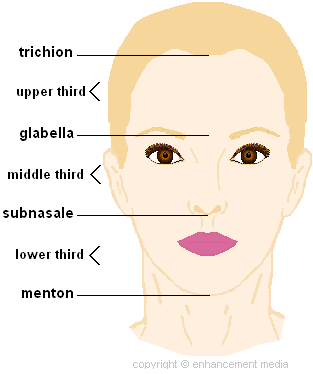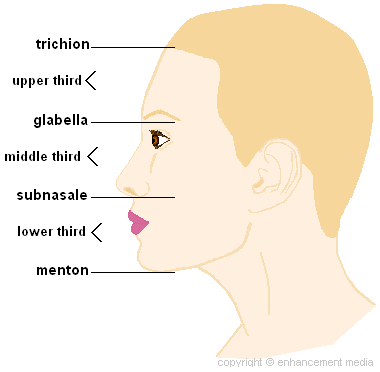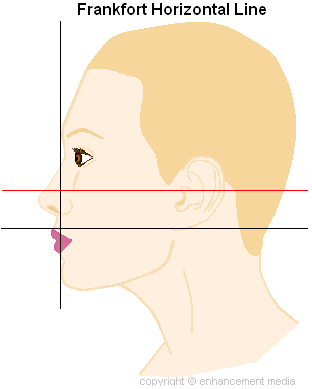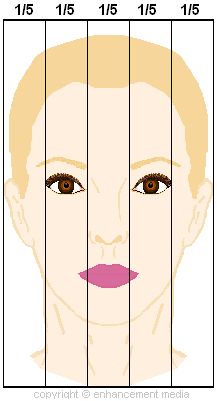Is There an Ideal or Perfect Nose?
Gertrude Stein said "rose is a rose is a rose." But "nose is not a nose is not a nose." The nose that would make you look wonderful could look bad on someone else's face. The right nose for you has to take into account the size and shape of your face, your ethnic background, and what your nose looks like now.
You may not realize that different ideas of what a perfect nose is have come in and out of fashion over the years. A very straight "Greek" nose (think of the nose on the Statue of Liberty) was the epitome of beauty for both men and women for a few hundred years. The earliest cosmetic rhinoplasty surgeries were often done to make the nose larger, because a small nose was associated with congenital syphilis.
To better understand the types of improvements than can be made in the nose shape and profile, visit the rhinoplasty before and after photo gallery.
Here is another example of how styles change: During the 1930s, women flocked to plastic surgeon's offices asking to have their nose made to look like that of Myrna Loy, star of the Thin Man movies. What looked lovely on the wonderful Ms. Loy—a nose with an up-tilted tip and arched nostrils—would probably have a woman asking for a nose job today.
So what makes a nose perfect for your face? Symmetry is considered beautiful in nature and in engineering, but a human being has character. Sometimes a little flaw adds a lot to a person's face, whether it is a family chin or an inherited high forehead. Think of the height of Glenn Close's forehead or Meryl Streep's slightly crooked nose.
Plastic surgery is not an exact science, but there are charts and measurements and even mathematical formulas that deal with determining an ideal facial structure. But these formulas are man-made, and beauty, as we all know, is in the eye of the beholder. This is especially true when you read sentences like: "The distance from the infraorbital rim to the base of the nose should be equal to the width of the nasal base (from the outside of each nostril to nostril) and 1/2 the distance of the middle third of the face (brow to the nasal base)." That is an actual sentence from a formula for determining a ideal nose.
All of these formulas are guidelines. None of them mean that if your nose is a few millimeters off of this mathematical ideal that you are unattractive. Every highly skilled cosmetic surgeon knows that the goal should be facial balance, or harmony, throughout the face. If the surgeon does not take your existing facial features into account, this balance will not happen. If you have a face that is a few millimeters larger or smaller and you get a by-the-book rhinoplasty, the nose you end up with could appear unnatural and even unattractive.
Sometimes, you may consult with a cosmetic surgeon about your nose and find out that your nose is not the problem. A receding or too-small chin can make your nose more prominent and make it look too big. Your surgeon may suggest that you undergo chin augmentation instead of a rhinoplasty or, more likely, along with it.
The most important factor in a cosmetic surgery is an artistic eye. You must find a plastic surgeon with this attribute or you may get a nose that does not suit you. You should definitely avoid any surgeon that gives all his or her patients the same nose. You have to look at many rhinoplasty before-and-after photos to get an idea of a given surgeon's style. It is important to find what you like, not what society deems an ideal nose.
Please remember that the artistic eye of the surgeon, along with good communication with the surgeon and realistic expectations from you will put you closer to your desired aesthetic goal.
Leonardo da Vinci, that all-around genius of science and art, developed a formula for determining a well-balanced face. He found that a well-balanced face can be evenly divided into thirds, vertically.
The top third is from your hairline to your glabella, which is the area between your eyebrows just above the top of your nose. The middle third is from the glabella to the bottom of your nose (the subnasale). The bottom third is from the bottom of your nose to your chin (the menton). The width of nose at its base should be about the same as the distance between the inner corners of your eyes.
 |
 |
CAPTION: "Ideal" Vertical Facial Dimensions
From the side, for an ideal face, you should be able to draw an imaginary straight line from the glabella through the base of your nose to the tip of your chin. This is called the Frankfort Horizontal Line. From the side, you can also determine two angles that cosmetic surgeons use when determining what would make a good nose for your face. These are the nasofrontal angle, from the glabella to the nose, and the nasofacial angle, from the nose to the Frankfort line of the face.
Horizontally, an ideal face can be divided into fifths, with the width of your nose as the center fifth. Your ideal nose and each of your eyes should (again, this is a generalization) be about the same width, horizontally.
 |
 |
Losing Track Of What is Attractive: When It Never Looks Like The Perfect Nose
 Be careful about overanalyzing your face and your nose. And be especially careful, if after several rhinoplasties, you just can't seem to be satisfied with how your nose looks. You may have lost sight of what looks attractive on you in your attempt to get the perfect nose.
Be careful about overanalyzing your face and your nose. And be especially careful, if after several rhinoplasties, you just can't seem to be satisfied with how your nose looks. You may have lost sight of what looks attractive on you in your attempt to get the perfect nose.
If you got the exact nose that you asked for and you still aren't happy, you should start thinking about what it is you truly want. Think again about what you are trying to achieve. What were your original reasons for rhinoplasty? You may be trying to change the rest of your life by changing your nose. This becomes unhealthy and dangerous.
No one wants to be told they have an image disorder. But it is important not to rule this idea out. Please, just consider the possibility of a self-image disorder if after two rhinoplasties by two surgeons, or one very skilled one, you are still not happy with your results. For more on this, read our section on. Beyond Typical Depression After Rhinoplasty Surgery.
For more information on breast procedures, please visit our gallery of breast augmentation before and after photos in Breast Implants 4 You.
